Decentralized social networks are exploring how to use blockchain technology to build a more fair and open future social interconnected environment in a modular and user data-driven way.
Author: Lemniscap / Source
Translation: Plain Blockchain

1. The Walled Garden of Social Media
In today's digital ecosystem, users find themselves confined within so-called "walled gardens," which are described as closed systems strictly controlled by large entities. These so-called digital platforms have influence over user identity, data, and even relationships between users, unilaterally setting rules for participation and developer interaction. This centralized control typically poses significant barriers to competitors and innovators, imposing high user conversion costs, extracting rents, and sometimes wielding power comparable to governments.
Dominant digital platforms retain the sole ability to modify, monitor, selectively promote, or censor information. They can access private messages, censor or boost content, and even impersonate users. Despite assurances of transparency and user interests, ultimate trust is placed in the belief that those wielding power will not abuse private data or suppress dissent. Algorithm-driven dissemination of misinformation erodes public trust. Entrusting speech control to central institutions poses a significant threat in a democratic society that views the press as the "Fourth Estate."
Social media has become a key force in shaping contemporary narratives. It can influence public opinion, drive political discourse, and even impact global events. The authority wielded by these platforms often sparks controversy, as they face accusations of censorship, bias, and manipulation. This influence was evident during the "Arab Spring," when platforms like Facebook and Twitter played a crucial role in mobilizing protest activities and disseminating information, challenging authoritarian regimes in the Middle East and North Africa. Another example is the Rohingya crisis in Myanmar.
One way to enhance the current state of social media is through decentralization, which involves transforming centralized platforms into distributed networks consisting of multiple independent nodes. This significant shift requires thorough reform of existing architectures from the ground up to facilitate peer-to-peer interaction and collective content management. This change aims to decentralize control and authority to a broader network while distributing the value created by the platform, potentially leading to more diverse and resilient social media interactions.
2. The Future of Social Networks
As concerns about censorship, privacy, neutrality, user control, and malicious behavior on centralized platforms grow, decentralization of social media is becoming a response. Decentralized social networks run on independently operated servers rather than on centralized servers owned by a single entity. Decentralized design grants users and independent developers greater autonomy and control, influencing the network's functionality and allowed content types.
This concept can be likened to the cathedral and the bazaar metaphor in software development. The cathedral model is a centralized effort where a defined group of developers, even just one, is developing software. This approach is more controlled and structured, reducing the scope for collaborative innovation. On the other hand, the bazaar model is open and collaborative, with many people improving the source code without central control. This approach leads to rapid experimentation, innovation, and network stress testing, as it allows a variety of individuals to contribute.
Web3 brings many benefits to the field of social media, addressing key issues inherent in centralized systems:
Reduced censorship and control: Decentralization significantly reduces the risk of any single entity censoring and controlling. In a decentralized network, there is no central authority with the power to unilaterally censor content or control the flow of information. This paves the way for a more neutral, unbiased media landscape, allowing for the development of diverse thoughts. Users can express their views without fear of being suppressed by platform owners, crucial for upholding freedom of speech and promoting open dialogue.
Fairer value distribution: On traditional social media platforms, the value generated from interactions between creators and users is often monopolized. Decentralization changes this dynamic by opening up a more equitable design space for aligning incentives among all stakeholders in the ecosystem.
Portability and open social graph: In decentralized systems, the open social graph means that user relationships and interactions are not confined to a single platform. Instead, they are permissionless and can achieve greater interoperability across different services and applications. This could lead to a more connected and seamless user experience while fostering innovation, as developers can build on existing networks without restrictions.
Data ownership: One of the most significant advantages of distributed social media protocols is that they enable users to own and control their own data. Unlike centralized platforms where companies own user data, decentralized platforms allow users to retain control over their personal information. This enhances privacy and enables users to decide how their data is used, and, if they choose, even monetize it. This also introduces the concept of "audience ownership," where creators have relationships with their audience, rather than the platform. This stands in stark contrast to centralized platforms like social media giants, where users may have thousands of followers but essentially "rent" access to the audience from the platform.
Composability and modularity: Decentralized networks are typically designed to be modular, composed of interchangeable components. This allows users to customize more flexibly, as they can choose which modules to use or even develop their own modules. Modularity also promotes platform development, as new features can be added or outdated features removed without disrupting the entire system.
Transparency: Transparency in social media is a key issue, and while decentralization may increase transparency, the open-source spirit fostered by decentralized narratives indeed promotes transparency. In decentralized networks, algorithms managing user-visible content, such as hiding content and promoting posts, can be open-source. Decentralization often requires open-source, as it disperses decision-making power and authority to the participant network, eliminating unnecessary intermediaries and enabling greater autonomy and transparency.
3. The Significance of the Farcaster Protocol in the Context of Distributed Social Networks
Every distributed social network relies on a "protocol," which is a shared language ensuring interoperability between different applications and services. These protocols can be likened to public infrastructure, similar to roads and sidewalks, facilitating movement between various destinations. Distributed social media platforms are built on distributed architectures, where control and decision-making are shared by participants collectively, rather than being centrally controlled by a single entity. Protocols are typically managed by core teams, often mission-driven nonprofit organizations responsible for setting standards and ensuring balanced, inclusive governance.
In terms of data storage and identity handling, distributed social media protocols adopt various approaches:
Federated protocols: Examples include Nostr, ActivityPub, and AT Protocol, which enable communication between servers. Users or organizations can host servers, although it requires a certain level of technical knowledge, leading to most users joining existing servers. Server administrators typically bear management responsibilities.
Blockchain-based protocols: Farcaster and Lens use blockchain technology, particularly at the identity level. A common misconception is that all interactions are stored on the blockchain, but this is often not the case.
Peer-to-peer approach: Scuttlebutt (SSB) is an example where individual devices act as servers. This model is more suitable for smaller-scale networks or communities.
The Web3 social landscape can be divided into four layers, although this representation is not exhaustive:
Hosting layer: This includes the blockchain for running social applications and distributed storage protocols for critical data.
Social primitives: These are the fundamental elements representing individuals, their behaviors, assets, and relationships.
Profile layer: Wallets serve as digital passports, enabling users to carry their data between applications and forming the basis of their Web3 social profiles.
Application: User interface applications leverage a combination of blockchain, storage protocols, and social primitives. These can be categorized based on interaction types: many-to-many (like Twitter), one-to-one (like WhatsApp), and one-to-many (like YouTube).
For example, Farcaster is a distributed social network that fully utilizes these layers of innovative use to create a more interconnected and user-empowered online social experience. In the following sections, we will explore Farcaster in more detail.
4. Farcaster: Pioneering the Decentralized Social Network Revolution
Farcaster stands at the forefront of digital evolution, embodying a protocol specifically designed for creating and connecting social applications in a decentralized manner. Its core mission is to create an anti-censorship environment, giving users absolute control over their data and audience connections. This approach marks a shift in traditional social media dynamics, opening up new realms for social autonomy and user empowerment.
Farcaster's architecture is built on a decentralized network, allowing users to maintain a unified social graph across multiple applications. Imagine a platform similar to Twitter, Instagram, and Facebook, harmoniously coexisting under a single decentralized identity. This structure ensures that users retain their identity and network connections, even if individual applications impose restrictions. It is a system designed to weaken the influence of centralized entities and return control to the users.
Farcaster's network is permissionless and open-source, encouraging developers to participate and innovate by integrating with its API and other applications. This accessibility fosters a mature environment for enhancing software functionality and improving user experience.
Fundamentally, Farcaster differs significantly from centralized applications like Twitter. Registration on Farcaster is based on a private key-public key pair, specifically an Ethereum address. The on-chain aspect of Farcaster primarily involves identity, where users forge a unique Farcaster ID (FID) serving as their permanent identifier within the Farcaster ecosystem. While FID is often referred to as a non-fungible token (NFT), it is important to clarify that it is more like an identifier. Each account can only have one FID, specified by the contract. This approach ensures censorship resistance, as FID is anchored on the Ethereum blockchain.
However, it is important to clarify what this mechanism actually achieves. While it ensures a message can be posted to Farcaster, it does not fundamentally guarantee that everyone can read that message. Suppose a censorship policy is implemented on Farcaster, filtering out messages from specific FIDs. This still constitutes application-layer censorship. This highlights a subtle challenge in decentralized platforms: while they can provide anti-censorship mechanisms at the protocol level, the application layer can introduce its own forms of content censorship and control.
Content, including the social graph, is stored off-chain in the Farcaster network at locations operated by entities called Hubs. These Hubs are similar to Ethereum nodes, and anyone can run a Hub. They ensure a consistent view of the network through message synchronization and exchange.
The first application built on Farcaster is "Warpcast," similar to a Twitter-like platform. However, the potential to expand to other social applications is extensive, such as Instagram, YouTube, or Substack, leveraging Farcaster's decentralized protocol. The system enables users to transfer their followers between applications, preventing applications from monopolizing users' social graphs and promoting novel experiences that combine social activities with on-chain data.
Farcaster's client-server relationship also sets it apart. Unlike Twitter, which operates in a client-server interaction model with centralized servers, Farcaster allows the existence of multiple servers, each providing different functionalities. This split of client and server reduces the risk of any single entity accumulating excessive power, echoing the flexibility of exporting Gmail contacts to Outlook or transferring assets between cryptocurrency trading platforms.
As a foundational protocol, Farcaster enables developers to build competitive clients on the same protocol. This approach is similar to different services, such as Substack and Mailchimp, built on the Simple Mail Transfer Protocol (SMTP).
As a user-centric platform, Farcaster leverages the Ethereum blockchain to create a decentralized registry for user identities. Unlike the need to generate new wallet addresses, new users register a Farcaster ID (FID) in the Farcaster contract using their existing Ethereum address. This FID is associated with their username, and while it is unique and serves as a permanent identifier within the Farcaster ecosystem, it is not a transferable non-fungible token (NFT) in the traditional sense, as each account can only have one FID. This system reduces the frequency of interactions with the blockchain in daily operations, improving user experience by avoiding regular gas fees.
Farcaster's innovative approach to social networks encompasses three core levels: the identity layer, data layer, and application layer. The identity layer is based on Ethereum, managing operations and authorizations. The data layer stores authorization information, while the application layer utilizes this data.
The protocol addresses several key challenges of decentralized social networks:
Identity: Users maintain consistent identities across applications through Farcaster ID and usernames.
Authentication: The authenticity of messages is verified through the sender's FID.
Availability: User data remains accessible across various applications.
Consistency: All applications adhere to the basic rules set by the Farcaster protocol.
The implementation of solutions to these issues by Farcaster has led to the development of various applications, including Alphacaster, Discove, Jam, Opencast, Warpcast, and Yup. These applications leverage Farcaster's protocol, providing diverse, user-centric social experiences similar to traditional platforms like Twitter but enhancing user autonomy and network portability.
5. Understanding the Farcaster Protocol
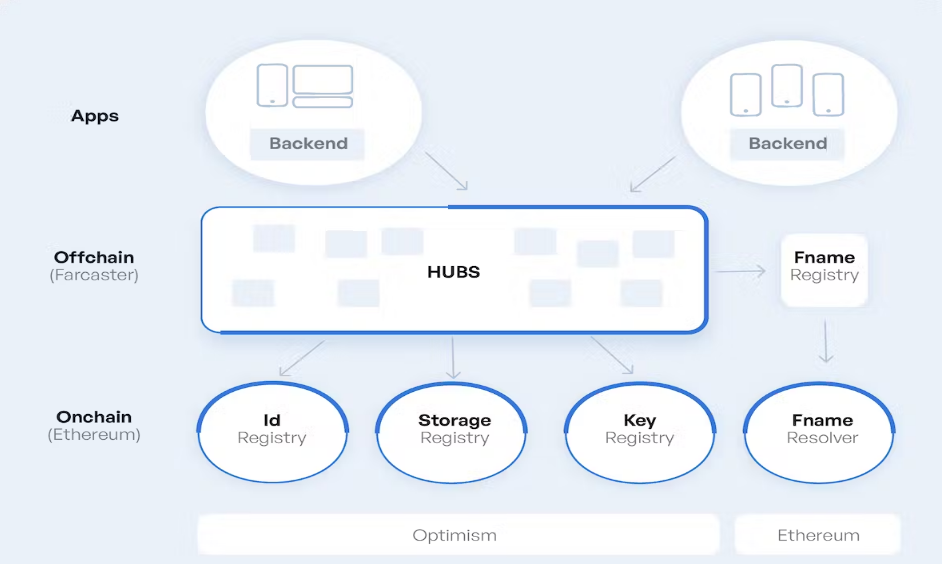
Application Integration with Farcaster: Applications developed based on Farcaster seamlessly interact with Hubs, a key component in the protocol architecture. These applications access, organize, and categorize data stored on Hubs through APIs to provide customized user experiences for various clients. This system ensures a dynamic and diverse range of applications, each catering to different user preferences.
Governance and Operational Standards: Farcaster adopts a governance model based on rough consensus and operational code. Protocol changes are driven by Farcaster Improvement Proposals (FIPs), requiring approval from a wide range of stakeholders, including protocol developers, application developers, and users. This consensus-based approach ensures a democratic and collaborative development process, without any single entity holding dictatorial power.
Social Ecosystem Partnerships: Farcaster's network extends beyond its core functionality to encompass various applications. These diverse functionalities include user notification systems, earning cryptocurrency platforms, social event notifiers, ecosystem metrics trackers, messaging applications, and decentralized news platforms, among others. These applications enrich the Farcaster ecosystem, providing users with a wide range of services and functionalities.
Sufficient Decentralization: Farcaster achieves what is known as "sufficient decentralization" by ensuring that users can always find and communicate with each other without external constraints. This level of decentralization is rooted in three key features: a unique identifier called Farcaster ID (FID), messaging under that name, and reading messages from any valid name. While Farcaster names (fnames) are centrally controlled by Warpcast and have the ability to revoke abusive names, FIDs are permissionless and on-chain, providing a stronger guarantee of resistance to censorship. Users can also further integrate their social identity with the Ethereum ecosystem by proving their FIDs are associated with the Ethereum Name Service (ENS) domain. This approach balances the demand for decentralization with practicality, avoiding the inefficiencies and high costs that a fully blockchain-based system might entail.
Network Expansion and Decentralized Name Registration: One of the challenges faced by decentralized social networks is scalability. Farcaster addresses this by allowing users to choose servers for message storage and using public/private key pairs for secure and unique identification. The hybrid off-chain/on-chain architecture allows data storage to be distributed across multiple servers, reducing reliance on a single centralized server and preventing bottlenecks as the network grows. Users can select servers for message storage without adding centralization or infrastructure pressure. Additionally, the protocol uses smart contracts to create a decentralized name registry, enabling users to associate their unique public keys with memorable usernames and host URLs. This system ensures that users can easily locate and communicate, maintaining the integrity of their connections.
Identity and Authentication: Farcaster introduces a robust identity and authentication system. Users have digital identifiers controlled by key pairs, with identity registered on a Turing-complete blockchain. This setup allows for key rotation and recovery, ensuring security and flexibility. Messages are signed using the user's key pair, ensuring tamper resistance and self-authenticating communication.
Message Graph and Applications: The Farcaster network is envisioned as a message graph representing users, content, and relationships in a social network. This structure is maintained by Hubs, which use Conflict-free Replicated Data Types (CRDTs) to synchronize the message graph. This mechanism achieves consensus without the need for coordination, ensuring data integrity and consistency on the network. Applications built on Farcaster can range from simple mobile clients to more complex systems with backends interfacing with Hubs, providing users with a variety of choices to meet their needs.
Hybrid Architecture of Farcaster: Farcaster's hybrid architecture combines on-chain and off-chain systems. It leverages smart contracts on Ethereum for identity registration, storage leasing, and key management. Off-chain Hubs provide high-performance data streaming, verifying and replicating messages in the network. This architecture facilitates the development of various applications within the Farcaster ecosystem, enhancing user experience and network capabilities.
On-Chain and Off-Chain Architecture: Farcaster's hybrid model is divided into on-chain and off-chain components to optimize security, consistency, and performance. On-chain operations executed on the Optimism Mainnet preserve key functions such as account creation, data storage payments, and application key management. These operations are minimized to reduce costs and enhance efficiency. Instead, the off-chain system powered by a peer-to-peer network of servers called Hubs handles most user activities. This includes message posting, user following, and profile updates. Off-chain activities prioritize performance and cost-effectiveness, utilizing on-chain signatures for security.
Hubs form a distributed server network crucial for storing and verifying Farcaster data, essential for both read and write operations within the Farcaster ecosystem. They initiate operations by syncing with the Farcaster contract on the blockchain to identify each user's account and keys. The processing of Farcaster messages includes creation, signing, uploading to Hubs, verification, and propagation to peer Hubs through gossip protocol.
Verification checks for valid signatures and compliance with protocol specifications. Storage conflicts, such as duplicates or overages, are resolved using CRDTs to achieve deterministic results. Hubs distribute messages using a gossip sub-protocol and ensure data integrity through differential synchronization with peer nodes, even achieving strong consistency after disconnections. However, messages may arrive in an unordered manner.
Hubs do not need to reach consensus on content between each other, as the on-chain components ensure message integrity and ownership through encrypted signatures. In cases of conflicting messages between two Hubs, on-chain data can be used to verify the authenticity and source of messages, resolving conflicts based on the immutable records on the blockchain. Hubs also assess behavior through peer scoring, maintaining network integrity by demoting peer nodes that do not meet standards.
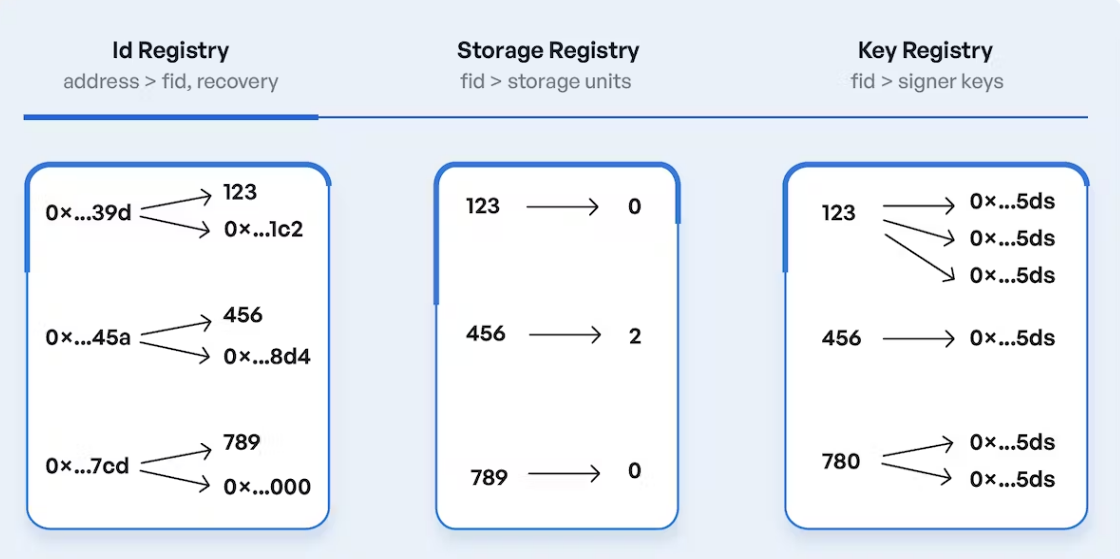
Core Contracts on the Optimism Mainnet: The on-chain functionalities of Farcaster are based on three main contracts deployed on the Optimism Mainnet.
Id Registry: Responsible for registering, transferring, and recovering Farcaster accounts.
Storage Registry: Manages account storage space leasing.
Key Registry: Allows accounts to issue keys for message posting to applications.
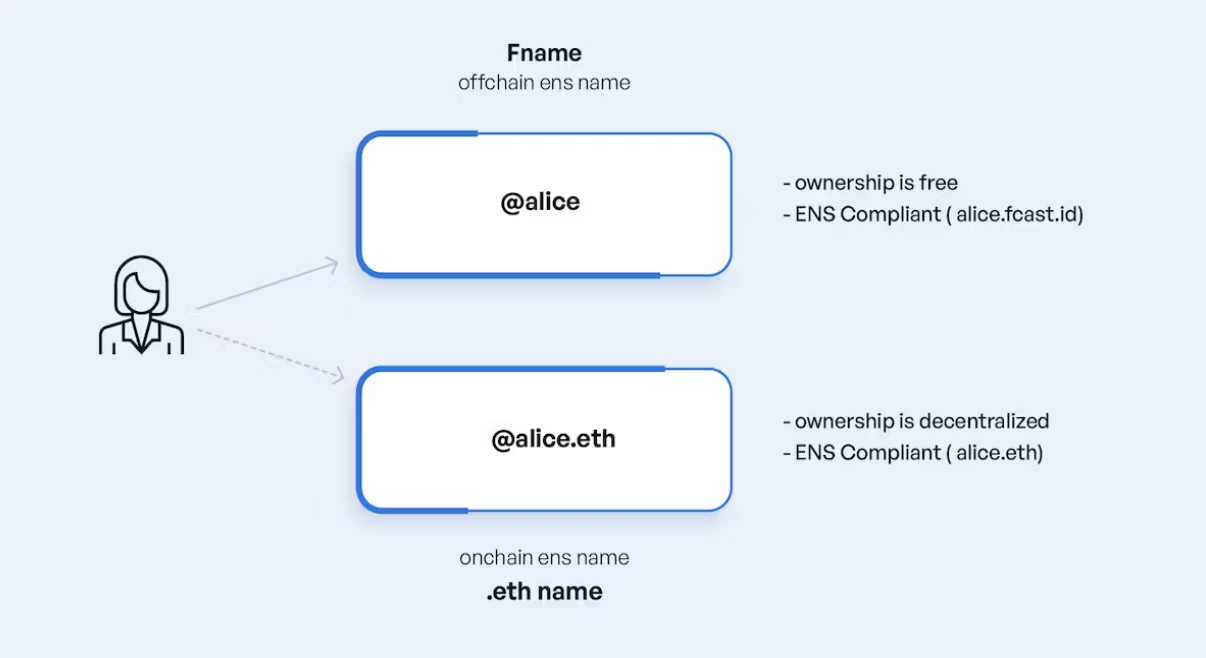
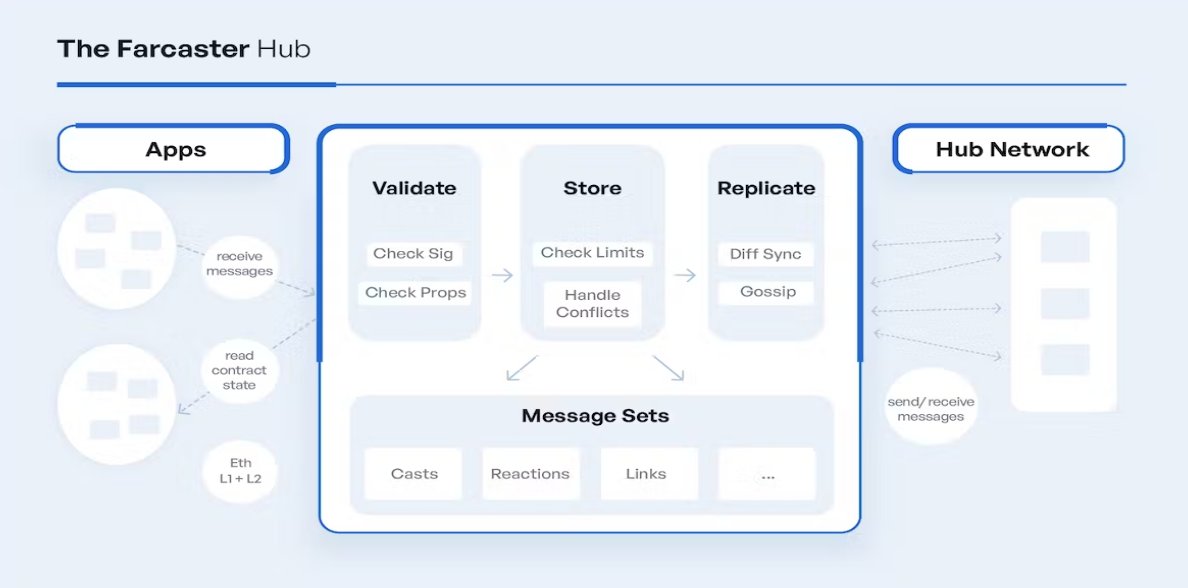
Farcaster Hubs - Off-Chain Backbone: Hubs constitute the core of the off-chain system in Farcaster. These distributed servers store and verify Farcaster data, synchronizing with off-chain data from Ethereum and other Hubs. They play a crucial role in reading and writing Farcaster data, and their accessibility allows anyone to run a Hub on various platforms.
Data Lifecycle and Verification: The process of Farcaster messages demonstrates the protocol's robust design. Once a user creates and signs a message, it is uploaded to a Hub, which verifies its authenticity and compliance with message types. After verification, the message undergoes conflict checks and is stored in the Hub.
Data Replication and Consistency: Hubs employ a two-stage process—gossip and diff sync—to ensure data replication. This system based on the gossip sub-protocol captures any missed messages through regular synchronization. While messages may be delivered in an unordered manner, Hubs maintain strong eventual consistency.
ENS Names and Usernames: Farcaster integrates ENS names as readable account identifiers, supporting off-chain ENS names (Fnames) and on-chain ENS names (e.g., @alice.eth). This dual approach meets user preferences for control and personalization. Fnames provide a free but managed option, while on-chain ENS names offer complete user control at a certain cost.
6. Farcaster Frames: A New Web3 Paradigm
Farcaster recently launched a significant feature called Farcaster Frames. Frames are a standard aimed at enhancing user interaction by seamlessly integrating external content within the application interface. It transforms casts into interactive mini applications within Farcaster. Frames combine static or animated visual elements with interactive elements, allowing users to interact with various external links and applications without exiting the app. These interactive buttons, when activated, send a POST request carrying a signed payload, enabling various dynamic user engagements. The core of Frames' operation is the EdDSA authentication system provided by Farcaster, ensuring a seamless and secure user experience across various platforms without the need to switch applications, thus avoiding potential mobile operating system issues related to deep link redirection.
Key Features:
User Experience (UX): Frames are inherently supported in all Farcaster clients, including Warpcast and Supercast, leveraging the EdDSA system. This integration allows users to interact directly with Frames from their Feed with a simple click, enhancing overall user engagement without the need for additional applications.
Security: By avoiding the use of ECDSA keys, Frames significantly reduce the risk of wallet theft. Additionally, since Frames are cryptographically signed, they cannot be forged.
Composability: EdDSA key pairs correspond to the user's FID, making it easy to obtain the user's social graph context. This is why token-based Frames are used for casting and revealing content that is already visible.
Following the introduction of the Frames feature, Farcaster's daily active users (DAU) have significantly increased, and developers have quickly adopted the platform to integrate native encryption features such as NFT casting and gaming. This surge in adoption demonstrates the potential of Frames in bridging the gap between independent, closed experiences, providing a unified and immersive user experience. Farcaster is actively developing enhanced features for Frames, focusing on text input, on-chain transactions, and improved privacy measures.
Hubs form a distributed server network crucial for storing and verifying Farcaster data, essential for both read and write operations within the Farcaster ecosystem. They initiate operations by syncing with the Farcaster contract on the blockchain to identify each user's account and keys. The processing of Farcaster messages includes creation, signing, uploading to Hub, verification, and then propagation to peer Hubs through gossip protocol.
Verification checks for valid signatures and compliance with protocol specifications. Storage conflicts, such as duplicates or overages, are resolved using CRDTs to achieve deterministic results. Hubs distribute messages using a gossip sub-protocol and ensure data integrity through differential synchronization with peer nodes, even achieving strong consistency after disconnections. However, messages may arrive in an unordered manner.
Hubs do not need to reach consensus on content between each other, as the on-chain components ensure message integrity and ownership through encrypted signatures. In cases of conflicting messages between two Hubs, on-chain data can be used to verify the authenticity and source of messages, resolving conflicts based on the immutable records on the blockchain. Hubs also assess behavior through peer scoring, maintaining network integrity by demoting peer nodes that do not meet standards.
7. Landscape of Decentralized Applications
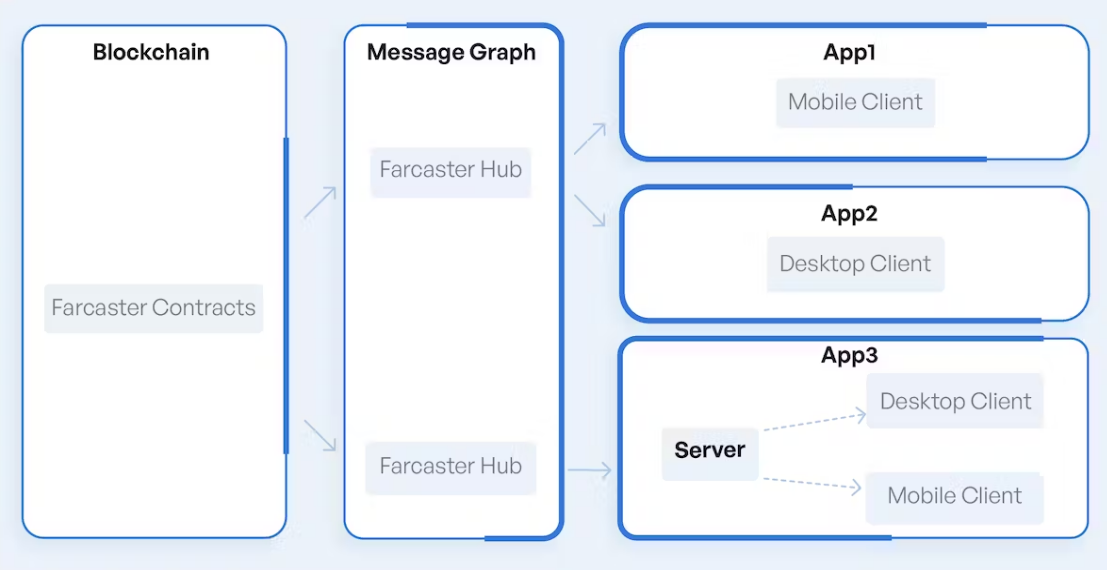
Farcaster, an emerging decentralized social networking platform, nurtures a vibrant ecosystem of diverse applications, each catering to different aspects of digital interaction and online community building. Here is an overview of some exciting applications that are utilizing Farcaster in unique ways:
Warpcast: Pioneering Social Networking
Warpcast is the flagship application in the Farcaster ecosystem, mirroring the user interface of traditional social networking sites like Twitter. This Web3 application is accessible through mobile devices and web browsers, allowing users to share posts (casts), interact with others, showcase their NFT collections, and seamlessly integrate their on-chain activities into their social dynamics.
Paragraph: Reinventing News Publishing
Paragraph reimagines publishing in the decentralized world, drawing inspiration from Substack in the Web2 space, enhancing the user experience with extensive customization options, automated email workflows, in-depth analytics, and team collaboration tools. Its unique features include casting, NFT memberships, token gating, and direct integration with the Farcaster social graph, opening new avenues for content monetization and audience engagement. Upon registering with an Ethereum wallet, Paragraph immediately leverages the user's Farcaster network to recommend news briefs from their relationship network. It allows users to subscribe to news briefs from their followers, view their followers' long-form content dynamics, and access popular posts shared within the Farcaster community. Paragraph also integrates Farcaster Frames into the brief experience, enabling users to subscribe to briefs with a single click and read posts directly from their Farcaster feed.
Kiwi News: Community-Driven Crypto Media Platform
Kiwi News is a crypto-focused media dApp centered around community engagement within NFT credentials. Users can share and vote to support various content such as podcasts, news articles, and videos. Kiwi News can be used as a web extension and application, providing an ad-free, noise-free experience, emphasizing community-curated content.
Wield: Making Crypto Exploration Fun
Wield is a wallet that offers a unique club membership model, allowing users to earn rewards through crypto transactions. It leverages Farcaster Layer 2 Cast to efficiently submit messages to a federated open center. This approach eliminates the requirement for on-chain storage fees and Farcaster ID fees. Farquest and Cast are prominent Farcaster clients built on the Wield platform, enhancing the Farcaster protocol experience. Cast is a well-known Farcaster client with approximately 15,000 daily active users, while Farquest gamifies the protocol, allowing users to explore and earn rewards in an RPG-style.
A Range of Utility-Focused Applications
The Farcaster community has developed a range of utility-focused applications, including:
castRSS: Integrates a user's Farcaster activities into other applications.
Launchcaster: Helps users discover new Web3 projects.
Fardrop: Allows the creation of allowlists based on followers.
RequestCaster: Serves as a public forum for product and feature requests.
Sharecaster: Enables users to create preview-friendly casts links.
8. Growth and Metrics
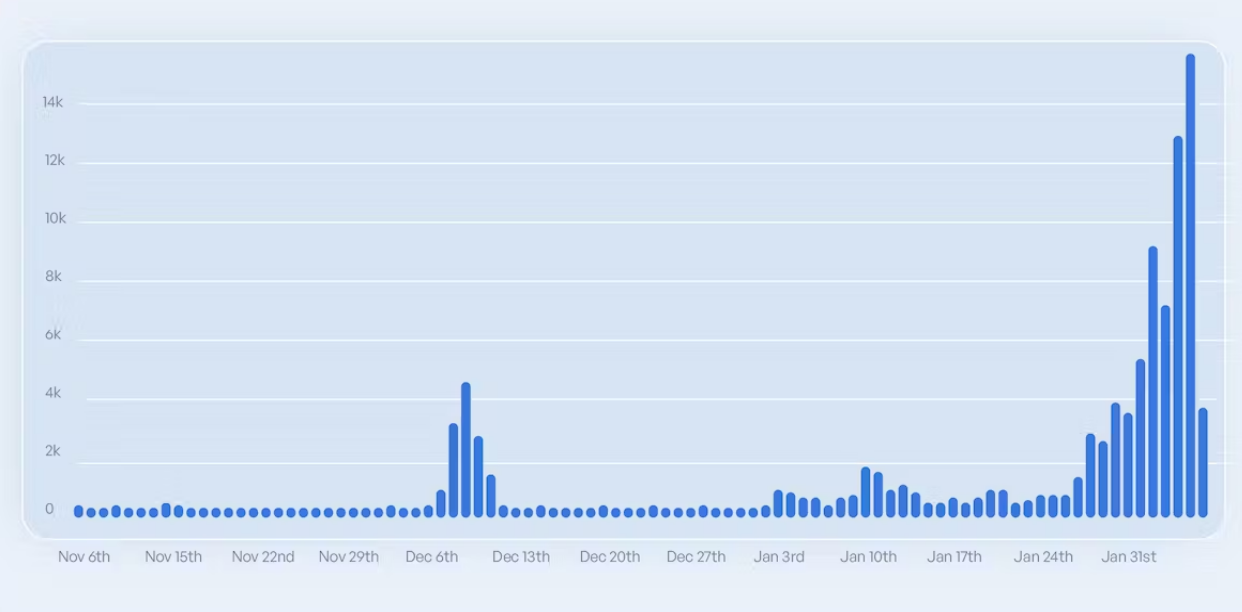
The chart shows a view of the protocol's user registration status. The initial registration trend shows a gradual increase, but after July 2023, there is a significant increase in registrations as the protocol shifts to a permissionless paid subscription model. The description above the chart is filled with expectations for 2024, reflecting an optimistic outlook on the future trajectory of user engagement with the protocol.
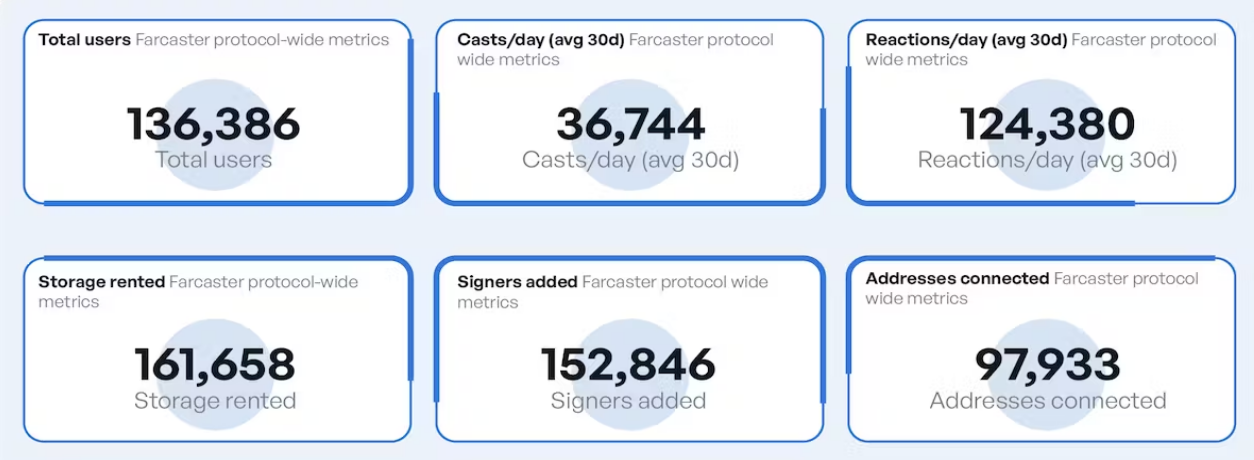
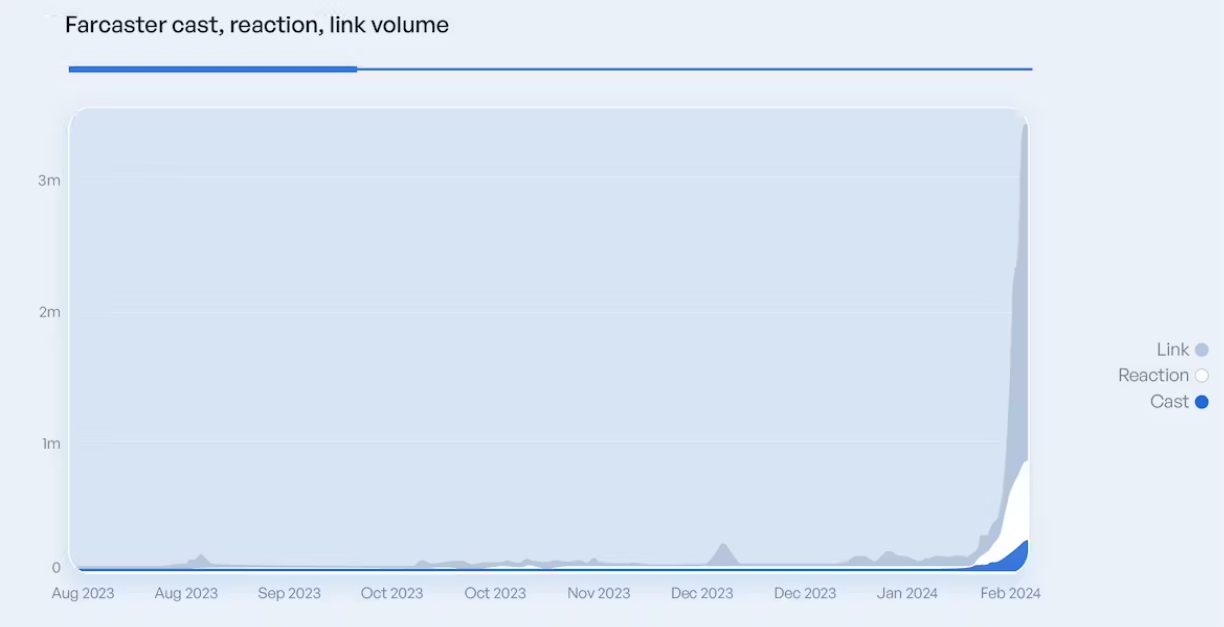
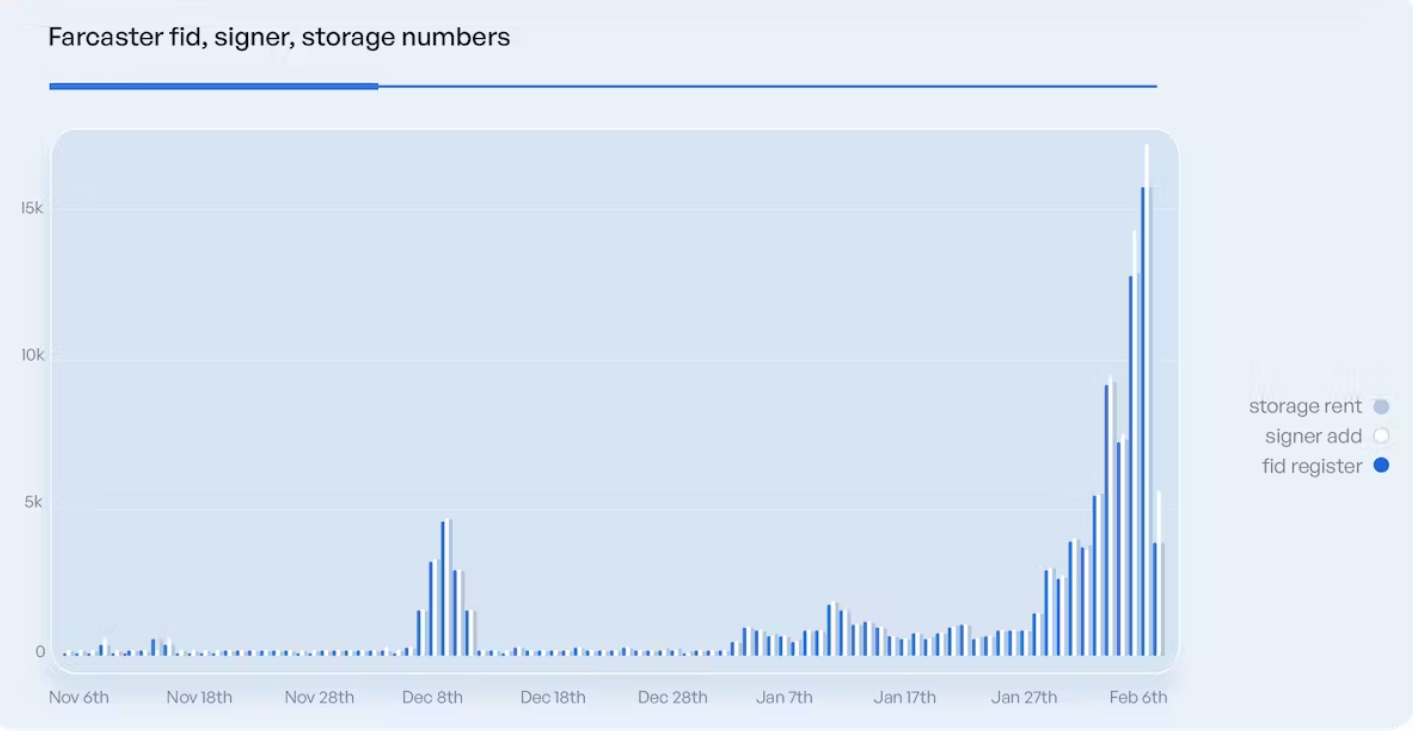
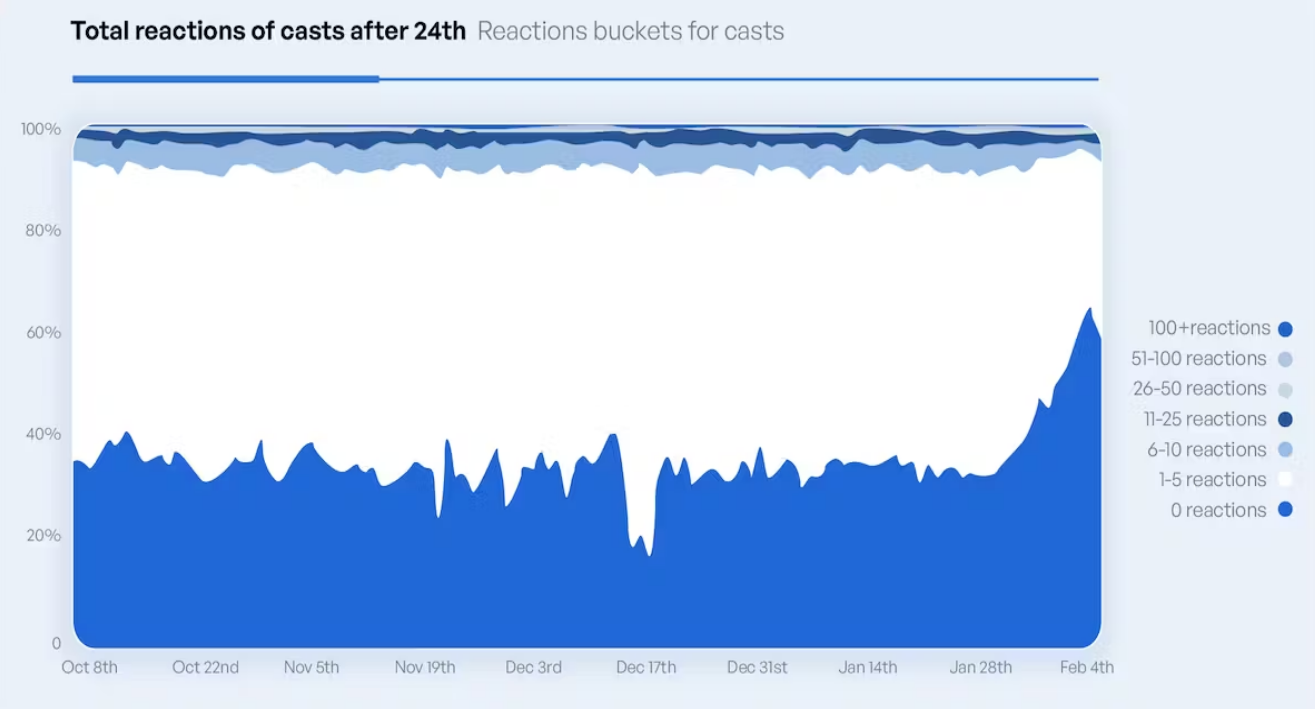
These charts provide a detailed view of the interaction dynamics within the Farcaster community, highlighting the characteristics of different types of posts in terms of content sharing patterns and corresponding levels of engagement. The first chart tracks three key metrics: links, reactions, and posts. Peaks in the chart indicate intermittent surges in activity, particularly significant peaks in the reaction component, indicating viral content or events triggering increased user interaction.
The Total Reactions After 24 Hours chart provides a breakdown of the number of reactions received by posts within 24 hours of posting. It is segmented into different ranges of reactions, such as 0, 1-5, 6-10, all the way to over 100 reactions, showing the distribution of engagement among posts.
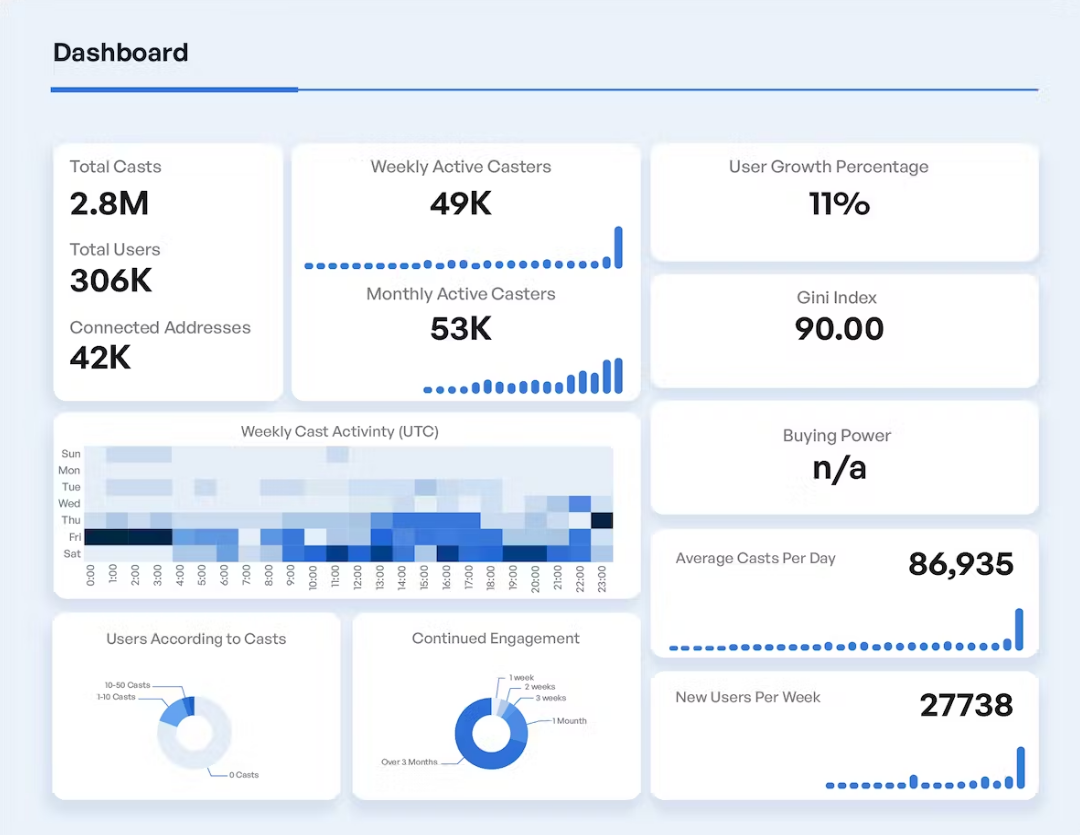
The data points on this dashboard vividly depict a thriving platform with sustained growth in engagement. The 2.8 million posts by 306,000 users indicate a strong and active user base. The weekly active users and monthly active users of 49,000 and 53,000, respectively, further highlight this healthy sustained engagement and indicate regular user return to the platform.
An 11% user growth rate and a high Gini coefficient of 90 indicate concentrated levels of activity within a smaller subset of users. This can be interpreted as a core, highly engaged community driving interaction on the platform, a common characteristic of emerging platforms.
The heatmap provides valuable insights into user behavior patterns in weekly post activity, showcasing the most concentrated periods of engagement. This data can be crucial in launching new initiatives or features during peak activity periods.
The "User Categorized by Posts" pie chart and the "Sustained Engagement" metric emphasize the platform's success in attracting and retaining users, a critical factor for long-term growth.
All these statistics collectively indicate that Farcaster is on the right track in building and expanding its user base.
9. Risks and Challenges
The rise of Farcaster faces significant challenges and adoption barriers, particularly concerning user experience and overall perception of decentralization. The existence of multiple clients complicates the task, each with slightly adjusted user interfaces crucial for achieving broader adoption. This technological divide may hinder mainstream users, who may prioritize interface familiarity and content richness over subtle differences in underlying technology. In this context, a relevant debate is the public's assessment of decentralization and censorship resistance. While appealing to privacy-conscious individuals, it is currently unclear whether the general user prioritizes these aspects over convenience.
Furthermore, the discussion about whether absolute decentralization is the ultimate goal, or whether a semi-decentralized moderation model similar to platforms like Wikipedia is more acceptable, is becoming increasingly relevant. For example, Farcaster adopts a sufficiently decentralized approach to gain the benefits of decentralization while retaining scalability and resistance to spam. This hybrid approach provides a balance between user autonomy and responsible content management.
As Farcaster expands, maintaining the integrity of the user base and community culture is also a challenge. The concept of nurturing a friendly and innovative digital environment must withstand the pressures of growth to ensure expansion does not erode these foundational values. Farcaster also faces fierce competition from Web2 giants and other protocols built on SocialFi in Web3, making market penetration and user conversion a daunting task.
Overall, decentralized social media platforms (such as Farcaster, Mastodon, Minds, and Lens) offer various advantages over traditional centralized platforms, including user control over data, censorship resistance, and increased privacy. However, they face significant challenges in achieving widespread adoption, such as:
Complex User Experience: Onboarding to decentralized platforms can be cumbersome, involving cryptocurrency transactions, wallet installation, and understanding of new protocols.
Difficulty in Scaling: Decentralized platforms often struggle to reach critical mass of users, which is crucial for the success of social networks.
Fragmented Landscape: Decentralized ecosystems are more challenging to navigate than centralized platforms, leading to user retention issues.
Lack of Moderation: Lack of centralized moderation can lead to the spread of rumors, online bullying, and criminal activities.
As the application layer on top of decentralized social media protocols gains increasing attention, the influence of large applications on the underlying protocol becomes an important but often overlooked topic. Large applications can significantly influence protocol development decisions, much like how a local policy change in Gmail might affect all other email providers, even in a decentralized email protocol. For a truly democratic and resistant-to-large-entity-influence decentralized protocol, it must either have mechanisms to counteract the rules of large entities or support a diverse competitive environment to prevent any single entity from unilaterally making changes.
10. The Way Forward
As we look to the future of decentralized social media, we stand on the brink of a significant shift that will fundamentally change the way we interact online. These advancements herald the arrival of a new era where our virtual experiences are not only more engaging and personalized but also built within a framework advocating user autonomy and collective governance.
1) Gaming and Commerce
Decentralized social media protocols will foster various secondary innovations. Exciting areas we are watching include gaming and commerce. Prospects include the development of games that leverage user engagement and wallet activity. This may resemble the early stages of Facebook games but without the notorious spam issues. Commerce also holds potential, where users can directly purchase NFTs and access professional services through Farcaster. Importantly, these developments on Farcaster will not encounter situations like Zynga vs. Facebook, where complementary solutions built on centralized platforms might suddenly become competitors, highlighting the platform risks associated with centralized platforms.
2) Decentralized Content Moderation
Although decentralized content moderation also needs to maintain a delicate balance between freedom of speech and preventing abuse, the difficulty lies in distinguishing acceptable from unacceptable content, a task influenced by the complexity of cultural differences and subjective interpretations. While there are no universally accepted standards of acceptability, democratic processes, such as those adopted by Wikipedia editors or federated social networks, provide a model for decentralized content moderation that is not controlled by private entities. The future of decentralized social media may involve a democratic content moderation approach, where users decide what is acceptable through debate and discussion, supported by technological tools and automation. This governance should be based on ethical principles, democratic control, and accountability, transcending simple resistance to censorship or authoritarian executive power. Currently, these functions are often bundled in a single entity, leading to issues of bias and lack of neutrality.
3) Social Media and Artificial Intelligence
The intersection of social media and artificial intelligence (AI) has been an active topic of discussion, primarily due to how AI algorithms utilize user data for targeted advertising and content. Twitter and other social networks use AI/ML models to analyze large amounts of personal data, customize user experiences, personalize content, and advertisements. This has raised concerns about privacy and data ownership, as these models are trained on user data that does not belong to the users. Decentralized social protocols introduce a fundamentally different dynamic, where users own and control their social networks. Users can "mint" posts and content, build their "on-chain content collections," and support content creators through microtransactions. In the context of recent developments in artificial intelligence, decentralized social models provide a unique advantage to users, enabling them to train their own AI models on their own data. As discussed by Fred Wilson in a recent article, users' on-chain collections can serve as personalized datasets for training these AI models. This allows training of AI models based on data directly relevant to the users, while respecting their privacy, as users can decide when and how to use their data.
4) Modular Approach
Adopting a more modular approach, where different aspects of the platform are independently managed, may help address these issues. This would involve separating the baseline protocol (which should be neutral) from the moderation layer, which can be customized based on the needs and preferences of different user groups.
In the broader context of decentralized social media, this modular approach could create more neutral "public squares" while still allowing effective moderation. This would make the end-user experience more valuable, meaningful, engaging, and useful, while rationalizing it by filtering out harmful participants and posts.
5) Expansion of Farcaster
The expansion of Farcaster into broader functionalities is noteworthy. This includes implementing verification mechanisms for real users' gifts and allowing external applications to log in using Farcaster accounts, enhancing ecosystem connectivity. Although Farcaster is still in its early stages, it shows tremendous potential and has sparked excitement similar to early-stage platforms like Clubhouse. It is focused on building a culture centered around Web3 and creators, which is evident. As Farcaster continues to develop, the question of the scalability of its high-quality user base will become increasingly important. The platform is committed to nurturing a friendly, optimistic, and innovative online space, setting it apart in the digital realm. Despite facing market challenges, its strategic vision and unique approach to decentralized social networking have inspired optimism and expectations for its future development.
Source: https://paragraph.xyz/@lemniscap/breaking-down-walled-gardens-farcaster
免责声明:本文章仅代表作者个人观点,不代表本平台的立场和观点。本文章仅供信息分享,不构成对任何人的任何投资建议。用户与作者之间的任何争议,与本平台无关。如网页中刊载的文章或图片涉及侵权,请提供相关的权利证明和身份证明发送邮件到support@aicoin.com,本平台相关工作人员将会进行核查。




